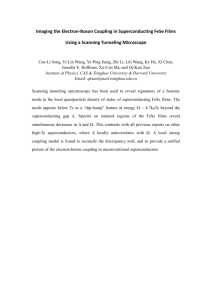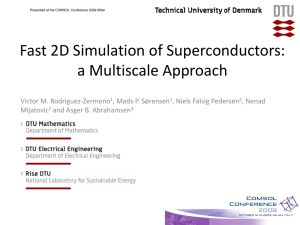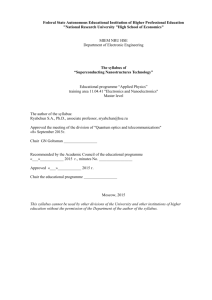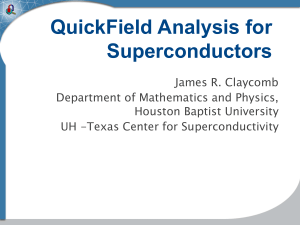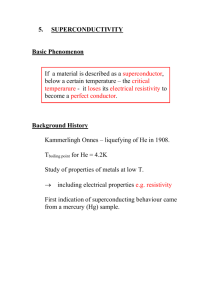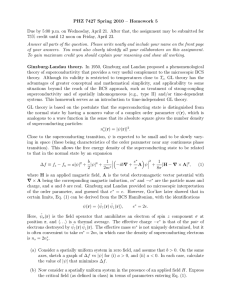CLASSICAL VIEWPOINT FERMI-DIRAC STATISTICS BOSE
advertisement
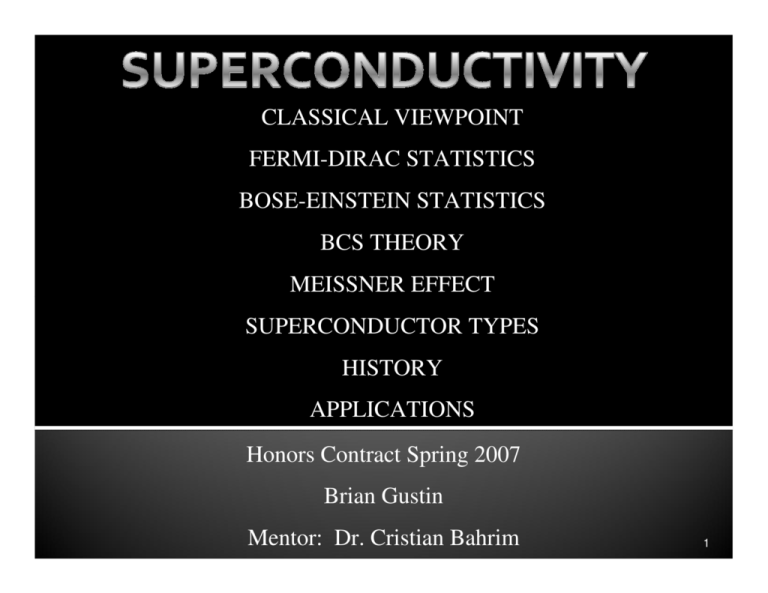
CLASSICAL VIEWPOINT FERMI-DIRAC STATISTICS BOSE-EINSTEIN STATISTICS BCS THEORY MEISSNER EFFECT SUPERCONDUCTOR TYPES HISTORY APPLICATIONS Honors Contract Spring 2007 Brian Gustin Mentor: Dr. Cristian Bahrim 1 RESISTANCE e- ρ = ρ 0 (1 + α ∗ ∆T ) where α is the temperature coefficient of resistivity (α > 0) ρ ≠0 because of impurities and defects in the crystal lattice at T=0K. R=ESISTIVITY For conductors as temperature decreases resistivity also decreases, but it reaches a constant value near zero Kelvin due to impurities and imperfections in the arrangement of atoms. TEMPERATURE (K) 2 1 f FD (E ) = ( E − E ) F kT + 1 e E > EF @ T = 0K fFD = 0 E < EF @ T = 0K fFD = 1 T=0 Kelvin T >> 0 Kelvin EF @ T ≠ 0K EF + kT k = 8.6 x 10-2 meV/T (Boltzman constant) @ T = 300K add kT = 25meV 3 1 f BE (E ) = E e kT −1 T=0K E=∞ → fBE = 0 E=0 → fBE = ∞ All bosons will condense on the lowest energy level in the solid. 4 • Normal solid states: p(E) = g(E) * fFD (E) where for electrons in metals g(E) ~ E1/2 (spin ↑/spin ↓) EF T = Tc • Superconductor electronic states: • If T > Tc then Cooper pairs form. • Their binding energy Eg ~ 10-3 eV • Eg can be broken with λ ~ 1.2 mm • As T decreases towards Tc, the energy gap Eg becomes smaller. • If T < Tc then Eg 0 and Cooper pairs are released. 5 • Fermions are particles with a spin ½ • Bosons are particles with an integer spin. (e.g. Cooper pairs have a spin of 0) • In a normal conducting material electrons collide with the crystal lattice creating resistance. • In superconductors @ low T the electrons pair into a new boson (the Cooper Pair). • When an electron of a Cooper pair collides with the lattice, it creates a disturbance that is transmitted solely to the other electron in the pair through the crystal lattice. This longrange interaction between electrons in the Cooper pairs is because of the conservation of linear momentum. 6 •Effect: Superconductors expel all magnetic field lines of an external solid magnet, and the magnet levitates. •If a large enough magnetic field is applied the superconductive behaviour disappears. •This value of B is known as being the critical field. 7 Element •Pure Elements •When cooled below a critical temperature, TC, these elements exhibit zero resistance. •These materials are usually insulators in a normal state. •Limited applicability and practicality because of small critical field values. W Ir Lu Hf Ru Os Mo Zr Cd U Ti Zn Ga Tc 0.015 0.1 0.1 0.1 0.5 0.7 0.92 0.546 0.56 0.2 0.39 0.85 1.083 Element Th Re Ti In Sn Hg Ta V La Pb Tc Nib Tc 1.4 1.4 2.39 3.408 3.722 4.153 4.47 5.38 6 7.193 7.77 9.46 8 •Usually made from alloys •Exhibit higher critical fields •Co-exist in a normal and superconducting state. This is sometimes called a vortex state because of the vortices of superconducting regions (small islands of supercoductivity). 9 •For T >> Tc normal states are closely packed together and make the material insulating. Normal Regions Superconducting Region •For T < Tc the normal states become smaller and the magnetic field that penetrates these small regions does not encounter any resistance, so the material shows superconductive behavior. •The area of the normal states has radius of about 300nm in type II superconductors . 10 1. The phenomenom was first discovered in 1911 by a Dutch physicist, Keike Kamerlingh Onnes. a.Onnes used mercury as his superconductor. b.Critical temperature of Mercury is about 4Kelvin (liquid helium). 2. 1987 Dr. Ching Wu Chu reports a critical temperature of 98 K a.98 K was a breakthrough Tc because liquid nitrogen (77 Kelvin) could now be used to obtain a superconducting state. Material Tc(K) Gallium 1.1 Aluminum 1.2 Indium 3.4 Tin 3.7 Mercury 4.2 Lead 7.2 Niobium 9.3 Niobium-Tin 17.9 La-Ba-Cu-oxide 30 Y-Ba-Cu-oxide 92 Tl-Ba-Cu-Oxide 125 11 •“Space Efficieny” e.g. 18000 pounds of copper wire were replaced by 250 pounds of superconductive cable. •No energy loss due to heat •Transformers can be made smaller and last longer. •An annual budget savings of almost 40% could be obtained with the replacement of copper wires with superconducting cables. 12 • Motors account for 70% of the power consumption in domestic manufacturing and 55% in the entire United States. High power electric motor produced for the US Navy (July 2001). • Using high-temperature superconducting (HTS) coils instead of traditional copper windings, this supermotor can produce more power in less space, and use less energy while doing it (high efficiency). • Most cruise ships and large naval vessels are switching to electric propulsion. • These units are quieter than traditional electric motors. 13 • A superconducting processor does not generate much heat. • This processor is only four bits compared with most of today’s 32 or 64 bit processors. • However, this four bit processor is 500 times faster than today’s common Intel processor. Japan •NASA and NSF are working for developing a superconducting chip. 14 Home Page. Superconductors.org. 12 April 2007. <http://www.superconductors.org> Home Page. hyperphysics.com. 12 April 2007. <http://www.hyperphysics.com> Krane, Kenneth. Modern Physics: Second Edition. John Wiley & Sons Inc, 1996. Mayo, Jonathan L. Superconductivity: The Threshold of a New Technology. TAB Books, 1988. 15

